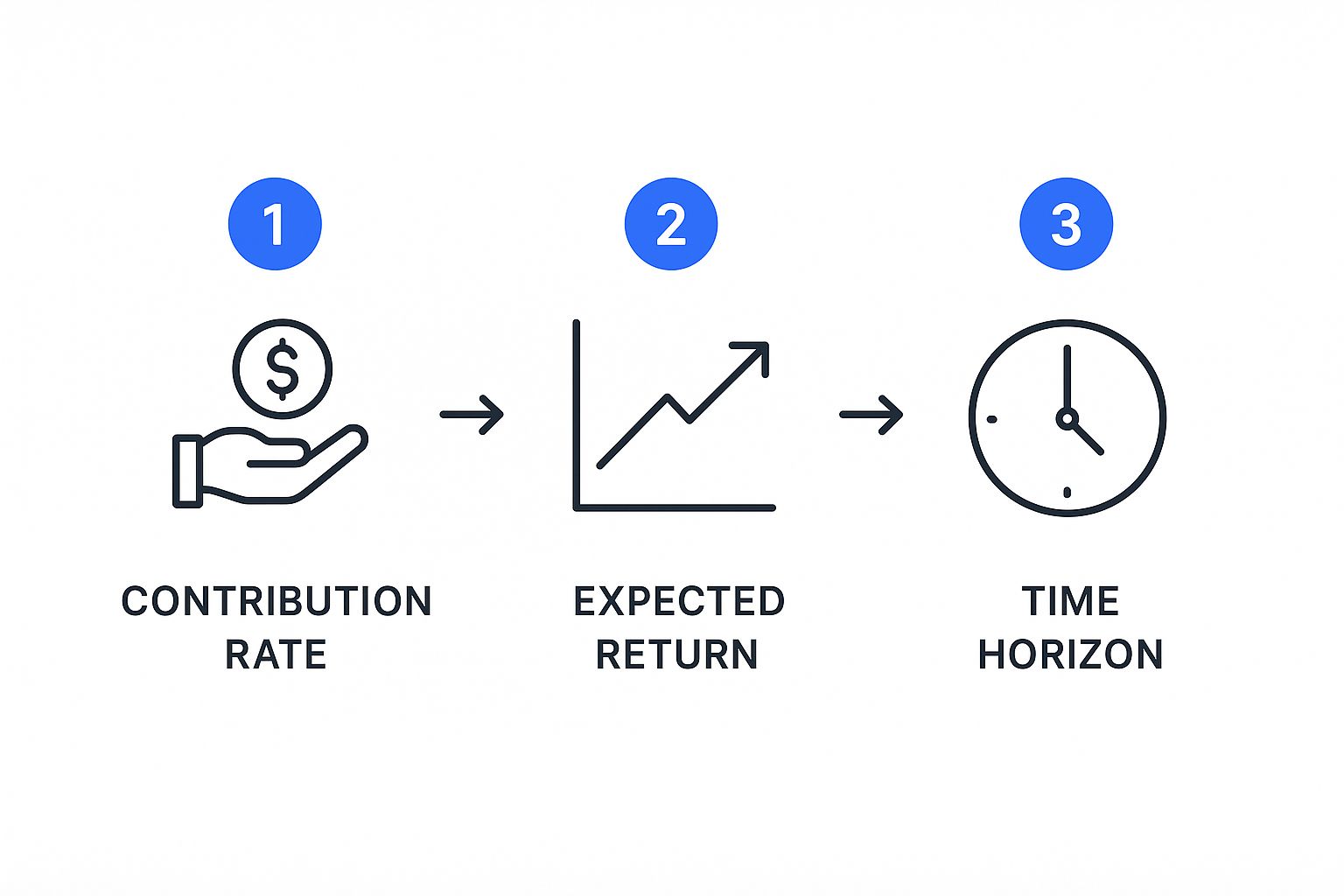Our Marketing Team at PopaDex
Retirement Nest Egg Calculator: Plan Your Future Today

A retirement nest egg calculator is an indispensable tool for anyone serious about their financial future. At its core, it estimates the total savings you’ll need to live comfortably once you stop working. It takes the fuzzy, often intimidating goal of “saving for retirement” and crystallizes it into a concrete financial target.
Why Retirement Planning Needs a Real Number

Vague advice like “save more” rarely works. In fact, it often leads to more anxiety than action. Without a specific number to aim for, how can you possibly know if you’re on track? You could be falling behind, or even over-saving at the expense of your current quality of life. This is where financial stress is born.
But a concrete number changes everything. When you use a retirement nest egg calculator, you’re not just playing with figures; you’re building a personalized roadmap. The process transforms saving from a daunting, endless chore into an achievable mission with a clear finish line.
Gaining Control Over Financial Unknowns
A huge source of retirement anxiety stems from unknowns like inflation and future healthcare costs. A good calculator forces you to confront these variables head-on. By inputting thoughtful estimates for inflation, investment returns, and how long you expect to live, you start building a much more realistic and resilient plan.
This isn’t about predicting the future with crystal-ball accuracy. Nobody can do that. It’s about understanding the impact of these powerful forces and building a strategy that can withstand them.
The psychological relief that comes from having a defined target is immense. It empowers you to make confident financial decisions, whether that means increasing your 401(k) contribution, exploring new investment options, or simply enjoying peace of mind.
From Chore to Confident Action
Knowing your target number is incredibly motivating. Suddenly, every dollar you save has a clear purpose. You can actually see how each contribution nudges you closer to your goal, which makes the entire process feel more rewarding. This clarity is a fundamental concept, and our guide on financial planning for beginners can help you build that foundational knowledge.
A solid retirement plan, anchored by a specific nest egg figure, allows you to:
- Track Your Progress: Easily measure exactly how close you are to your ultimate goal.
- Make Informed Adjustments: Decide with confidence when to ramp up savings or tweak your investment strategy.
- Reduce Financial Stress: Replace that nagging worry with a genuine sense of control and purpose.
Ultimately, a retirement nest egg calculator is far more than a mathematical tool. It’s a device for turning abstract financial fears into a concrete, manageable plan, giving you the confidence you need to build the future you envision.
Getting Your Financial Ducks in a Row

Before you can get a meaningful number from any retirement calculator, you’ve got to feed it the right information. Think of it like cooking: the final dish is only as good as the ingredients you start with. This isn’t the time for guesstimates. It’s time for a clear-eyed look at where you stand financially, right now.
First up, you need a firm handle on your current retirement savings. This is the bedrock of your entire plan, the foundation all future growth is built on. It means logging into your accounts and finding the exact balance for each one. Don’t forget about that old 401(k) from a job you left years ago or the Roth IRA you opened and forgot about. Every single dollar is part of the equation.
Your Current Savings Snapshot
To get a complete picture, you’ll need to pull up the most recent statements for every account you’ve designated for retirement. This is the core data that makes any calculation worthwhile.
- Workplace Retirement Plans: This is your 401(k), 403(b), or 457(b). Make sure you’re looking at the total vested balance—that’s the amount you’d walk away with if you left your job today.
- Individual Retirement Accounts (IRAs): Find the current value of any Traditional, Roth, SEP, or SIMPLE IRAs you’re holding.
- Other Investment Accounts: If you have a separate brokerage account that you’re earmarking for retirement, you’ll want to include its balance, too.
These balances represent all the hard work you’ve already put in. They’re the starting line for the growth you’re about to project. If you want a structured way to track all this, our retirement planning checklist can be a huge help in keeping things organized.
One of the biggest mistakes people make is underestimating what they’ve saved—or worse, having no idea at all. Taking a moment to gather these precise numbers is the first real step toward taking control of your financial future.
Next, you need to pinpoint your contribution rate. How much are you actively saving for retirement each month or year? This number is what fuels your nest egg’s growth. Be sure to combine your personal contributions with any employer match you receive. That match is free money, and it’s a critical part of your total savings effort.
It can also be helpful to see how you stack up. The total value of U.S. retirement assets has ballooned to around $44.1 trillion, with IRAs alone making up about $14.52 trillion of that. While the average 401(k) balance is reported as $134,128, these figures swing wildly depending on age and income, which really drives home how personal this journey is.
Before you plug any numbers into a calculator, a solid understanding of your overall personal finance picture is non-negotiable. With these key pieces assembled—your starting balance and your ongoing savings rate—you’re officially ready to move forward.
How to Set Your Calculator’s Key Variables
A retirement nest egg calculator is a fantastic tool, but its magic lies in the numbers you feed it. Garbage in, garbage out, as they say. Getting your projections right isn’t about wild guesses; it’s about being thoughtful and realistic with each input. This is where a generic estimate transforms into a personal roadmap for your future.
The truth is, even a tiny tweak to one variable—like your assumed inflation rate—can dramatically alter your final nest egg number over a few decades. Let’s walk through how to approach these crucial assumptions so you can build a plan you actually trust.
Nailing Down Your Retirement Lifestyle Needs
First things first: how much money will you actually need each year once you hang up your work boots? A popular rule of thumb is to aim for 80% of your pre-retirement income. So, if you’re making $100,000 now, that method suggests you’ll need $80,000 a year.
That’s a decent starting point, but I find a more tailored approach works better. Take a hard look at your current spending. Your lifestyle isn’t going to flip upside down the day you retire. A better way is to look at your current take-home pay and then subtract the big-ticket items that will likely vanish:
- Mortgage payments (assuming your home will finally be paid off!)
- Retirement savings contributions (you’ll be withdrawing, not adding)
- Work-related costs (goodbye, daily commute and work wardrobe)
This bottom-up method gives you a much more personalized number. Be brutally honest with yourself here. Are you planning epic globetrotting adventures, or is a quiet life with the grandkids more your speed? Your answer will make a huge difference.
The infographic below shows how the core components of your savings work in tandem to grow that nest egg over time.

As you can see, your contribution rate, expected return, and the time you have are the three legs of the stool supporting your retirement wealth.
Before diving into the numbers, it’s essential to understand the key inputs that drive any good retirement nest egg calculator. The table below breaks down the most critical variables, what they mean, and provides some common ranges to help you make more educated guesses.
Key Inputs for Your Retirement Nest Egg Calculator
| Variable | What It Means | Example/Common Range |
|---|---|---|
| Current Age & Retirement Age | The starting and ending points of your savings journey. | Current: 35, Retirement: 65 |
| Annual Retirement Income | The amount of money you’ll need each year after you stop working. | 70-85% of pre-retirement income |
| Current Savings | The total amount you’ve already saved for retirement. | $50,000 |
| Annual Contribution | How much you plan to save for retirement each year going forward. | 10-15% of your gross income |
| Pre-Retirement Rate of Return | The average annual growth you expect from your investments while saving. | 5-8% (net of fees) |
| Post-Retirement Rate of Return | The more conservative return you expect when you’re living off your nest egg. | 3-5% (net of fees) |
| Inflation Rate | The rate at which the cost of living increases, eroding your purchasing power. | 2.5-3.5% (historical average) |
Getting these inputs right is the foundation of a reliable projection. Use them as a guide, but always tailor them to your personal situation and risk tolerance.
Balancing Risk and Realistic Returns
Now for the big one: your investment rate of return. You’ll need to estimate this for both your saving years (pre-retirement) and your spending years (during retirement). This is easily one of the most powerful variables in any retirement calculator. A higher return means your money does more of the heavy lifting, which can reduce how much you need to sock away from your paycheck.
The most common mistake I see? Over-optimism. Sure, the stock market has historically delivered average annual returns near 10%, but your personal return is dictated by your unique mix of stocks, bonds, and other assets.
A conservative investor with a bond-heavy portfolio might assume a 4-5% average annual return. A more aggressive, stock-focused investor might feel comfortable plugging in 6-8%. It’s always a smart move to use a lower rate for your retirement years, as your focus will shift from growth to capital preservation.
The sheer scale of retirement investing in the U.S. is staggering—these assets represent 34% of all household financial assets. With a total U.S. retirement market valued at over $43.4 trillion, even small market wobbles can have a massive ripple effect on individual portfolios. This is precisely why a realistic, even slightly conservative, rate of return is a cornerstone of any solid plan. You can find out more about U.S. retirement market trends to get a bigger picture.
Finally, you absolutely cannot forget inflation. The long-term average hovers around 3%, and ignoring it is a rookie mistake that can sink your plan. A steady 3% inflation rate will cut your purchasing power in half every 24 years. Factoring it in properly ensures your nest egg can support your lifestyle not just on day one of retirement, but for all the decades that follow.
Turning Your Results Into an Actionable Plan

Alright, you’ve run the numbers through a retirement nest egg calculator and now you have it. A big, important number staring back at you from the screen. This figure isn’t some final verdict on your financial destiny; think of it as the starting line for taking smart, confident action. What you do next is what really counts.
Seeing your retirement number for the first time can spark a few different reactions: relief, excitement, or a sudden knot in your stomach. No matter which one you feel, the goal is exactly the same—turn that number into a concrete plan.
Let’s break down how to read your results and build a real strategy around them.
What to Do If You Have a Savings Gap
If the calculator shows a shortfall between what you’ve saved and what you need, take a breath. Don’t panic. This is incredibly common, and more importantly, it’s fixable. A gap is just data telling you that your current approach needs a tune-up.
Your first move should be to grab the low-hanging fruit.
For instance, are you contributing enough to your 401(k) to get the full employer match? If you’re not, make that your immediate priority. An employer match is essentially a 100% return on your investment. You just won’t find a better deal anywhere. Leaving that money on the table is like turning down a pay raise.
Once you’ve locked down the full match, it’s time to look at automating your savings even further.
- Automate IRA Contributions: Set up a recurring monthly transfer from your checking account to a Roth or Traditional IRA. Even $100 a month adds up massively over time thanks to compounding.
- Increase Your 401(k) Percentage Annually: Many plans have an auto-increase feature that bumps your contribution by 1% each year. It’s a small, gradual change you’ll barely notice in your take-home pay, but it can close a savings gap much faster than you’d think.
These small, automated tweaks are so powerful because they put your savings on autopilot. You’ll consistently chip away at that gap without having to rely on sheer willpower.
“Your retirement number isn’t a final verdict; it’s a starting line for informed action.”
This perfectly frames the situation. The number you see isn’t the end of the story; it’s a diagnostic tool. It shows you exactly where you need to make adjustments, empowering you to steer your financial ship in the right direction.
Staying Motivated When You Are on Track
What if your retirement nest egg calculator shows you’re right on track to hit your goal? First off, congratulations! Seriously, take a moment to appreciate the results of your discipline and hard work. Your mission now shifts from playing catch-up to maintaining momentum and protecting what you’ve built.
Your primary focus should be consistency. Keep doing what’s clearly working, but also be on the lookout for ways to optimize. Could you shift to lower-fee index funds within your 401(k)? Is your portfolio’s asset allocation still a good fit for your age and risk tolerance?
Being on track also gives you a fantastic opportunity to zoom out and look at your total financial health. A strong retirement fund is a huge piece of your wealth, but it’s not the only piece. To get the full picture, you can use other tools to see how all your assets—and debts—fit together.
In fact, you can learn how to track your total financial picture with our net worth calculator (https://popadex.com/net-worth-calculator/) to see how your growing nest egg impacts your overall wealth. Seeing the entire board helps you stay motivated and make even smarter decisions for the long haul.
Advanced Strategies to Fine-Tune Your Plan
Once you have a baseline number from a retirement calculator, the real work—and the real fun—begins. It’s time to move beyond the simple inputs and start building a plan that’s tough enough to handle the complexities and curveballs life will inevitably throw your way. This is where you shift from just saving to truly strategizing for your financial future.
A great starting point is looking at common withdrawal theories, like the well-known “4% Rule.” The basic idea is that you can withdraw 4% of your nest egg in your first year of retirement and then adjust that amount for inflation each year without running out of money. It’s a fantastic benchmark, but it’s important to remember it was developed in the 1990s. It doesn’t always account for today’s longer lifespans and the potential for lower market returns.
Stress-Testing Your Retirement Plan
A single projection is a good start, but a truly solid plan is one that has been pressure-tested. Life rarely moves in a straight line, and your retirement strategy shouldn’t assume it will. This is where stress-testing comes in—it’s how you prepare for the best, the worst, and everything in between.
Think about major life events that could throw a wrench in your plans and run those numbers.
- Career Changes: What if you switch jobs and face a temporary dip in income? Or what if you lose a valuable employer match for a few years?
- Health Crises: How would a significant medical bill, not fully covered by insurance, impact your savings rate or force an earlier-than-planned withdrawal?
- Market Downturns: What happens if the market takes a 20% nosedive right after you retire? Running this scenario helps you understand “sequence of returns risk” and how it can dramatically affect how long your money lasts.
Running a best-case, worst-case, and most-likely scenario gives you a full spectrum of possibilities. This isn’t about trying to predict the future with a crystal ball; it’s about building a plan with enough wiggle room to succeed no matter what comes.
Integrating All Income Sources
Your retirement investments are just one piece of the puzzle. For a truly accurate picture of your financial independence, you have to account for every source of income you’ll have. It’s easy to overlook things like pensions or Social Security, which can lead you to believe you need a much larger nest egg than you actually do.
For instance, many retirement calculators will ask you to estimate your future Social Security benefits. You can get a personalized estimate directly from the Social Security Administration’s website. If you’re one of the lucky few with a pension, dig up that statement to find your projected monthly or lump-sum payout.
Subtracting these guaranteed income streams from your annual spending needs reveals the real gap your personal savings need to fill. To get even more granular with how different investment choices could shape your portfolio, you can use an investment calculator. This final step ensures your retirement calculations are based on the most complete and accurate data, giving you a target that reflects your entire financial reality.
Common Questions About Retirement Calculators
Even after crunching the numbers and running a few scenarios, it’s completely normal for questions to bubble up. Retirement nest egg calculators are fantastic tools, but they’re not magic. To really get the most out of them, you need to understand their quirks and what they’re truly designed for.
So, let’s dive into some of the most common questions we hear from people just like you.
One of the first things people ask is, “Can I even trust this number?” It’s a fair question. The best way to view a calculator is as a powerful estimation engine, not a crystal ball. Its output is only as good as the assumptions you feed it—things like your expected investment returns and how much you plan to spend.
Think of the calculator’s result as a solid baseline. It’s a starting point for a much richer conversation, ideally one you have with a financial pro who can pressure-test your assumptions and add real-world context.
How Often Should I Recalculate My Nest Egg?
Your financial life doesn’t stand still, and neither should your retirement plan. A good rule of thumb is to revisit your retirement calculator at least once a year. An annual check-in is the perfect time to update your account balances, factor in a raise, and tweak your strategy.
But life happens. You should also get back to the drawing board after any major life event that could knock your financial plan off its axis.
- A big promotion or a new job. This will change your income and could affect your access to workplace retirement plans.
- Getting married or divorced. Merging finances or untangling them demands a complete rethink of your retirement goals.
- Welcoming a child. This introduces brand new, long-term costs that need a spot in your budget and savings plan.
- Receiving an inheritance. A sudden windfall can be a huge accelerator for your retirement, but only if you plan for it properly.
Treat your retirement plan like a living document. Regular updates keep it aligned with your current reality, ensuring you’re always on the most direct path to your goals.
The Biggest Mistake to Avoid
The single biggest blunder we see people make? Plugging in wildly optimistic return rates. It’s so tempting to assume 10% or more year after year, hoping historical market averages will do all the heavy lifting. This can create a dangerously rosy picture, tricking you into thinking you need to save far less than you actually do.
A much smarter, safer approach is to use a conservative rate, something between 5% and 7%, during your saving years. This bakes a buffer right into your plan. If the market does better? Fantastic—you’ll just hit your goal sooner. That’s a way better problem than staring down a massive shortfall later.
Another classic pitfall is underestimating what you’ll spend in retirement, especially on healthcare. Don’t just pull a number out of thin air and assume your spending will magically drop by 20%. A detailed budget that accounts for travel, hobbies, and potential medical bills will give you a much more realistic—and achievable—target.
Ready to stop guessing and start tracking? The PopaDex net worth tracker consolidates all your accounts into one clear dashboard, giving you the real-time clarity needed to turn your retirement goals into reality. Get started for free today.